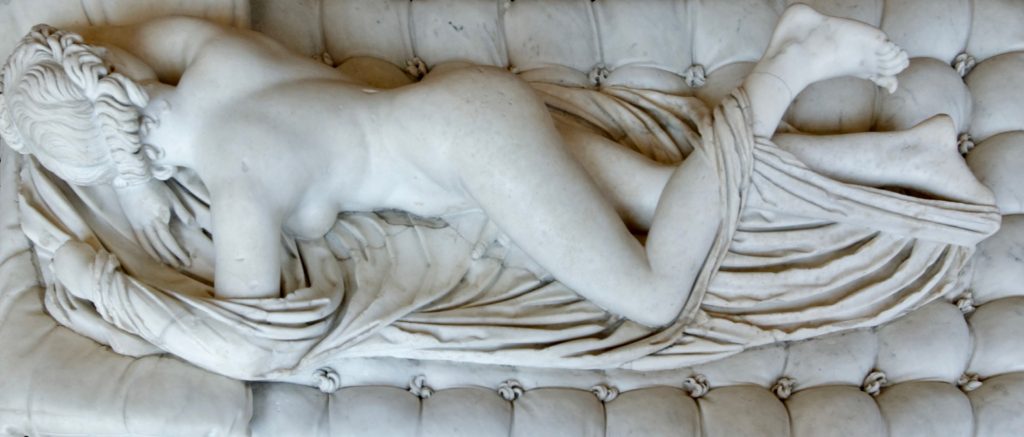Greek Statue of Hemaphroditus 2d Century BCE – Louvre.
Every human being was originally one combined gender —male and female together. This unity was violently severed, creating separate males and females. This story comes to us from the writings of Plato who extensively quoted the playwright Aristophanes. This explanation clears up the issue of why men and women crave to be united — and also explains homosexual attraction. We are still grappling with these ancient issues.
The Greek Origins of Male and Female Dichotomy

Above: Plato’s original androgynous human, Androgyne. Detail from ancient Greek amphora. Below: The origins of modern day acceptance of androgyne
October, 2019. Plato wrote a book, “The Symposium”, which cites speeches from Aristophanes, the Greek playwright. Here is Aristophanes explaining the origin of gender:
“In the beginning, humans were androgynous. Not only did early humans have both sets of sexual organs, Aristophanes reports, but they were outfitted with two faces, four hands, and four legs. These monstrosities, the Androgynes, were very fast – moving by way of cartwheels – and they were also quite powerful. So powerful, in fact, that the gods were nervous for their dominion. Zeus, Greek king of Gods, was afraid that the Androgynes would conquer the gods. Wanting to weaken the humans, Zeus,, decided to cut each in two, and commanded his son Apollo ‘to turn its face…towards the wound [shifted from facing backward to facing forward] so that each person would see that he’d been cut and keep better order.’ If, however, the humans continued to pose a threat, Zeus promised to cut them again – ‘and they’ll have to make their way on one leg, hopping!’”
The severed humans were a miserable lot, Aristophanes says:
“[Each] one longed for its other half, and so they would throw their arms about each other, weaving themselves together, wanting to grow together. Thus, these severed Androgynes were still living in despair. Finally, Zeus, moved by pity, decided to turn their sexual organs from their back to the front side, so they might achieve some satisfaction in embracing.”
Plato also writes of the origin of same and opposite sex urges. In the same “Symposium” cited above, Aristophanes uses the tale of the androgynes to explain homosexual behavior. It turns out that some of the androgynes consisted of either two men fused together, or two woman. This Plato “Symposium” quote below has been lightly edited for clarity only:
“Men who are a section of that double nature which was once called androgynous [made up of a man and a woman] are lovers of women, adulterers are generally of this breed, and also adulterous women who lust after men. The women who are a section of a double-woman androgyne do not care for men, but have female attachments: the female companions [that is, lesbians] are of this sort. But they who are a section of the double male follow the male, and while they are young, being slices of the original man, they have affection for men and embrace them [the Greek verb implies a sexual sense], and these are the best of boys and youths, because they have the most manly nature.” [citing a scholar named Crompton. Cites omitted.]

It is a fact hidden until recent times is that the Ancient Greeks broadly accepted, and indeed celebrated, homosexuality, which is one extension of androgyny. In contrast, androgyny in modern, pop-celebrity culture arguably began with these two pop tarts. Below left: Early pioneer Iggy Pop got androgyny beauty off to a slow start, but it picked up nicely with David Bowie on right


